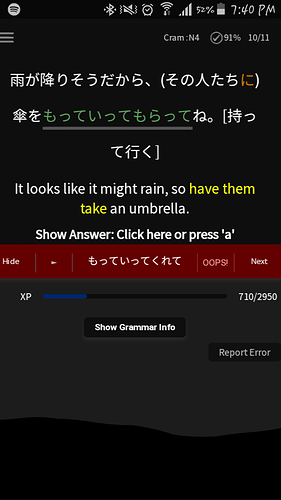From what I’ve seen, you generally use もらう to indicate getting someone to do something for you.
But for this sentence in particular, the に in parentheses is critical. For くれる, に indicates the person being given the thing/favor. For もらう, に indicates the person giving the thing/favor. It’s a bit confusing for a sentence like this because the “favor” is so abstract (them taking the umbrella at your request), but I think it still makes sense.
Also, here’s a random tidbit that might be helpful. It took me a really long time to remember which actors got に for each of these, but I finally realized a few months ago.
- あげる - to give. Since the verb has to do with giving, the giver is the subject (が) which means the receiver is marked with に.
- くれる - to be given. Same explanation as with あげる.
- もらう - to receive. Since the verb has to do with receiving, the receiver is the subject (が), which means the giver is marked with に (or から sometimes).
I thought it was this way too, but recently I read “Making sense of Japanese” by Jay Rubin, and he make a great case that あげる and くれる both means “to give”. He especially warn against using passive in English to translate くれる as “to be given”.
Here is the relevant part :
Kudasaru and kureru also mean “to give,” but the direction of the giving is always from the other person to the speaker or someone in his group, exactly the opposite direction of ageru etc., but still “giving” and not “receiving.” The speaker describes the giving as being done by someone else-someone outside his group-toward him. X o kureta, then, is usually going to mean "He gave me X or “She gave us X” etc. It will never mean “I gave him X,” and perhaps more importantly, it will never mean “I got X from him.” The other person is the subject, the doer, the giver, the one who initiates the action of giving.
[…]
As with ageru, kureru can follow a -te form to indicate the “giving” of the action described by the -te verb, but of course the action is initiated by the other person for “me.” Inu o aratte kureta without a stated subject does not mean “Someone washed the dog for me,” and it especially does not mean “The dog was washed for me.” It means “He (or she, etc.) washed the dog for me.” The direction of the giving is fixed, always from the other person. Thus, even though no subject may be stated within the Japanese sentence, we know from the meaning of the verb that it is somebody else, and we know from the particular context whether it is “he” or “she” or “you” or “they.” “Someone” is always wrong as a translation for a known but unstated subject.
Because あげる and くれる both mean “to give”, just going opposite direction, they work the same way. が marks the subject, the doer, the giver and に mark the receiver. So, back to the original sentence, 傘を持っていってくれた would mean They/He/she brought an umbrella for me/us.
If your point is simply that くれる is not passive, then sure that’s fair. I used the common English translation to not bother explaining the difference between あげる and くれる since it wasn’t relevant to the question.
This is fine in isolation, but not relavent for this example.
- Based on the English translation, the sentence needs て form, not past tense. くれて as a command/request sounds wrong to me (but someone can correct me if they have a case where it’s valid).
- More importantly for this example is the その人たちに as I already mentioned. For the given English translation, this part of the sentence makes it impossible to use くれる since it would completely change the meaning of the sentence.
Sorry, I completely forgot to wrote that I totally agree with your answer about why くれる is not possible here (に mark the receiver and with くれる the receiver can’t be その人たちに, as you said). Also you’re right I made a mistake, it’s て form, not past.
Basically, I just wanted to share some additional info, by pointing out why あげる / くれる share the same grammatical structure. Also I saw the “to be given”, remember about reading the cool stuff I quoted above and jumped on it, sorry about that 
Thank you guys very much!!!
Now I think I finally understood these three grammar points!
I’ll add some information.
あげる and くれる both means ‘give’. They are both used in different way. あげる is used when a giver (you or someone in your in-group) gives something to the recipient (or someone in the recipient’s in-group). The recipient MUST not be you. くれる is used when a giver (or someone in the giver’s in-group) gives something to you (or someone in your in-group). もらう means ‘receive’. It is used when a recipient (or someone in the recipient’s in-group) receives something from the giver (or someone in the giver’s in-group). The giver MUST not be you.
The choice between くれる and もらう depends on the context.
Examples:
あげる:
私は友だちにゲームをあげました。
 友だちは私にゲームをあげました。
友だちは私にゲームをあげました。
 友だちは(私に)ゲームをくれました。
友だちは(私に)ゲームをくれました。
くれる:
友だちは(私に)お土産をくれました
 私は(友だちに)お土産をくれました。
私は(友だちに)お土産をくれました。
 私は友だちにお土産をあげました。
私は友だちにお土産をあげました。
もらう:
私は友だちに本をもらいました
 友だちは私に本をもらいました。
友だちは私に本をもらいました。
All of these are also applied for (〜て)あげる, (〜て)くれる, and (〜て)もらう.
Sources: The Dictionary of Basic Japanese Grammar

